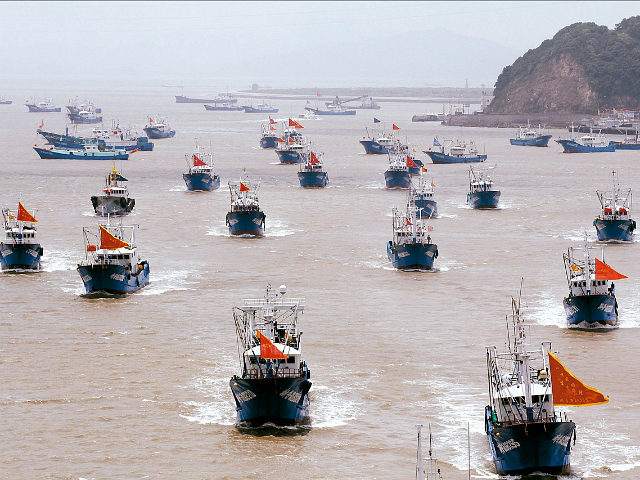WASHINGTON, DC – The United States should keep an eye on China’s rapidly growing naval forces, a part of which China has hidden as civilian fishing boats, a prominent U.S. expert on China warned at an event on Wednesday.
China’s regular navy already has more ships than the U.S. — a little more than 300 to the U.S.’s 277. But Andrew Erickson, a professor at the U.S. Naval War College’s China Maritime Studies Institute, warns that it is China’s informal sea forces that need close watching.
At an event hosted by the Jamestown Foundation, Erickson described the three elements of China’s maritime forces: the navy, coast guard, and a maritime militia – or, as he said a friend’s five-year-old son acutely described it: “a regular navy, the police navy, and the sneaky navy.”
The “sneaky navy” refers to the maritime militia, which China passes off as civilian fishing boats but consists of thousands of vessels and personnel, who are fishermen by day but are organized and trained as a militia that can be called up as needed.
That maritime militia is aimed at overpowering its neighbors and advancing China’s control over the South China Sea where six nations have disputed territorial claims. An estimated $5 trillion in global trade also passes through the South China Sea.
Erickson said the maritime militia has a small elite subcomponent at the top, entrusted with participation in sea encounters and incidents with other nations.
Now, he said, China is developing an even more elite force, which consists of 84 vessels that are each nearly 200 feet long and up to 750 tons, have powerful water cannons, strong external rails useful for ramming other boats, and engage in exercises like loading light weapons.
“These folks don’t fish,” he said.
Rather, he said, they do rotational forward deployments to China’s outposts in the Spratly Islands, a group of islands, reefs, and other land features in the South China Sea.
“They are hiding in plain sight,” he said. “I hope people pay more attention to it.”
He said China’s coast guard is also the largest in the world, with 225 ships that are over 500 tons and another 1,050-plus ships confined to closer waters — a total of about 1,275 ships.
The coast guard, along with the maritime militia, can focus on securing China’s coast and backfilling lower-end missions, while China’s regular navy – the People’s Liberation Army Navy – can feel comfortable shifting some of its emphasis outward, he said.
On how well this was working, Erickson responded, “They’re good enough to keep winning in the gray zone, which is where China wants to play.”
The gray zone refers to a space between peace and war where there is conflict below the threshold of conventional warfare — which complicates a U.S. response to that conflict.
Cristina Garafolo, a policy analyst with RAND who also spoke at the Jamestown Foundation event, said she has also seen the People’s Liberation Army Air Force (PLAAF) exercise over longer distances, farther away from China’s shores.
She said the Japanese military has released some data showing it scrambled its aircraft almost 50 percent more in 2016 than it did the year before, which typically happens when another country’s aircraft approaches its airspace.
The growing number of those incidents could lead to “potential conflict,” she said.
Experts at the event said Chinese President Xi Jinping has made clear his ambitions for China to reach world superpower status, militarily dominate the East Asia region, and reunify with Taiwan by 2049.
Jamestown Foundation senior fellow Willy Lam said Xi is expected to break tradition and serve for longer than two five-year terms, perhaps serving as many as 20 years.
Xi — regarded as the most powerful and experienced leader since former Chinese President Deng Xiaoping — has both the motivation and the ability to reform the military in keeping with China’s great power image, they said.
He is also trying to blend civilian and military sectors together, including emerging technologies like artificial intelligence, which the U.S. government is currently struggling to do.
Particularly telling is Xi’s call last year to ordinary civilians to “respect the tradition of [People’s Liberation Army] predominance,” Lam said.
According to Lam, during a visit in Inner Mongolia last November 30, Xi recalled how during the War of Liberation, ordinary Chinese put the military before themselves.
“The masses ‘will send their last bowl of rice for military consumption, last yard of cloth to make military uniform, last cotton quilt to cover [wounded soldiers lying on] on stretchers; and the last child to the warfront,’” Xi said, according to Lam.

COMMENTS
Please let us know if you're having issues with commenting.